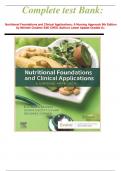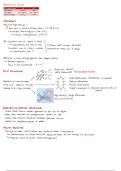Complete test Bank:
Nutritional Foundations and Clinical Applications: A Nursing Approach 8th Edition
by Michele Grodner EdD CHES (Author) Latest Update Graded A+.
, Table of Contents
PART I: Wellness, Nutrition, and the Nursing Role
1. Wellness Nutrition
2. Personal and Community Nutrition
PART II: Nutrients, Food, and Health
3. Digestion, Absorption, and Metabolism
4. Carbohydrates
5. Fats
6. Protein
7. Vitamins
8. Water and Minerals
PART III: Health Promotion through Nutrition and Nursing Practice
9. Energy, Weight and Fitness
10. Nutrition across the Life Span
PART IV: Overview of Medical Nutrition Therapy
11. Nutrition Assessment and Patient Care
12. Food-Related Issues
13. Nutrition for Disorders of the Gastrointestinal Tract
14. Nutrition for Disorders of the Liver, Gallbladder, and Pancreas
15. Nutrition for Diabetes Mellitus
16. Nutrition in Metabolic Stress: Burns, Trauma, and Surgery
17. Nutrition for Cardiopulmonary Disease
18. Nutrition for Diseases of the Kidneys
19. Nutrition for Neuro-Psychiatric Disorders
20. Nutrition in Cancer and HIV-AIDS
,Chapter 01: Wellness Nutrition
Grodner et al.: Nutritional Foundations and Clinical Applications: A Nursing Approach, 8th Edition
MULTIPLE CHOICE
1. Examples of informal education include
a. attending a workshop on coronary artery disease sponsored by the American Heart
Association.
b. watching a television show about diabetes.
c. learning about food safety techniques in a high school economics course.
d. joining a support group to help overcome an eating disorder.
ANSWERS: : B
Watching a television show about diabetes is an example of informal education because it is
an experience that occurs through a daily activity. Attending a workshop or joining a support
group would be considered nonformal education; a high school course would be considered
formal education.
DIF: Cognitive Level: Applying REF: Page 13
TOP: Nursing Process: Implementation MSC: Client Needs: Health Promotion and Maintenance
2. A college student exercises regularly and generally eats a healthy variety of foods, is taking a
course in general nutrition, buys locally produced food whenever possible, is an active
member of an on-campus faith-based organization, and keeps a journal to help process her
emotions. What else could b eNi mR
p o r tIan t Gf o r B
h e.r C
t o inMclude in her life in order to develop her
overall wellness?
a. Growing some of her own food
, b. Keeping a food record to help evaluate what she eats
c. Eating meals with friends throughout the week
d. Meeting with a registered dietitian to review her food choices
ANSWERS: : C
Wellness enhances a person’s level of health through development of each of the six
dimensions of health: physical health, intellectual health, emotional health, social health,
spiritual health, and environmental health. Exercise and eating a healthy variety of foods help
develop physical health; taking a course in general nutrition helps develop intellectual health;
buying locally produced food helps develop environmental health; being part of a faith-based
organization helps develop spiritual health; and keeping a journal helps develop emotional
health. The missing dimension in this example is development of social health; eating meals
with friends throughout the week would add this dimension. Growing her own food would be
another example of environmental health; keeping a food record would be another contributor
to physical health; and meeting with a registered dietitian may contribute to physical,
intellectual, and emotional health.
DIF: Cognitive Level: Analyzing REF: Page 7 | Page 8
TOP: Nursing Process: Assessment MSC: Client Needs: Health Promotion and Maintenance
3. For a client who is missing meals because of poor planning or is too busy to eat, emotional
health can be affected by , which can cause confusion or anxiety.
, a. low plasma sugar levels
b. high plasma sugar levels
c. high plasma pressure
d. extremely low plasma pressure
ANSWERS: : A
Poor eating habits affect emotional health. Missing meals may cause plasma sugar levels to
decrease, which can cause anxiety or confusion or make difficult to control emotions. Late
night binges on snack food are likely to result in excessive energy intake but would have a
less direct effect on emotional health. Eating small meals throughout the day is likely to
maintain more constant plasma sugar levels, which would actually have a positive effect on
emotional health. Excessive caffeine consumption may contribute to anxiety, but 2 cups of
caffeinated coffee is not considered excessive.
DIF: Cognitive Level: Analyzing REF: Page 6
TOP: Nursing Process: Assessment MSC: Client Needs: Psychosocial Integrity
4. The best example of the type of concern that is likely to be addressed by the U.S. Department
of Health and Human Services when target goals for Healthy People 2030 are updated is
a. preference for vegetarian eating patterns among white women.
b. low intake of fruits and vegetables by African American children.
c. widespread use of bottled water in higher socioeconomic groups.
d. common use of protein and vitamin supplements in athletes.
ANSWERS: : B
Healthy People is used to set targets for health promotion to improve the health of all
individuals. It addresses environmental and social issues that affect health outcomes. Low
intake of fruits and vegetableN
sUb yRA
SfIricNaGn TABm.e rCi cOa nMc h i l d r e n is likely to have an adverse
, effect on their health and so may be addressed when target goals are set. Vegetarian eating
patterns, use of bottled water, and use of protein and vitamin supplements do not necessarily
have an adverse effect on nutritional health and so are less likely to be addressed.
DIF: Cognitive Level: Applying REF: Page 9 | Page 10
TOP: Nursing Process: Planning MSC: Client Needs: Health Promotion and Maintenance
5. An example of community support for health promotion is
a. teaching a young mother skills in safe food preparation.
b. watching a television documentary about industry errors in food processing.
c. labeling fresh poultry packages with information about proper food storage.
d. being aware that Salmonella can be trAnswers: mitted because of
inadequate food preparation.
ANSWERS: : C
Food labeling information is an example of community support because it is a regulatory
measure that supports new health-promoting behaviors within a social context. Teaching,
watching television, and awareness may increase knowledge, but they do not alter the social
context by regulation or environmental change.
DIF: Cognitive Level: Applying REF: Page 8
TOP: Nursing Process: Implementation MSC: Client Needs: Health Promotion and Maintenance
6. An example of a technique for health promotion is
, a. exercising five times a week.
b. local supermarkets’ expanding the availability of fresh fruits and vegetables.
c. teaching a teenager how to choose healthier foods at fast-food restaurants.
d. information about the relationship of dietary intake and diet-related disorders.
ANSWERS: : C
Health promotion consists of strategies that are designed to improve the health of individuals,
families, groups, and communities, such as teaching a teenager how to choose healthier fast
foods. Exercising regularly contributes to wellness, but it is not bringing about a change in
health unless this is a change in behavior. Stocking a wider availability of fresh produce does
not promote health, unless the supermarket uses specific strategies to encourage consumption.
Information about the relationship between nutrients and disease is simply information unless
it is used to promote behavior change.
DIF: Cognitive Level: Applying REF: Page 7 | Page 8
TOP: Nursing Process: Implementation MSC: Client Needs: Health Promotion and Maintenance
7. For the efficient functioning and maintenance of the body, a person needs to consume
sufficient amounts of
a. fiber.
b. nutrients.
c. minerals.
d. supplements.
ANSWERS: : B
The body needs sufficient amounts of all nutrients for efficient functioning and maintenance.
Both fiber and minerals are needed, but each represents only one type of nutrient.
Supplements are not always N ceRssSaI
neU ryNbG auBs.
ecT eCs uOf f M
i c i e n t nutrients can often be obtained from
, food.
DIF: Cognitive Level: Understanding REF: Page 5
TOP: Nursing Process: Assessment MSC: Client Needs: Physiological Integrity
8. A nurse has just been assigned to a community health program for older adults. She should
check the document Healthy People 2020 to become familiar with
a. nutrition priorities and goals for older American adults.
b. dietary standards for AmericAnswers: older than 50 years.
c. dietary guidelines recommended for older adults.
d. MyPlate recommendations for older adults.
ANSWERS: : A
Healthy People 2020 focuses on targets and goals for improving the health of the nation. The
nurse would check the Dietary Reference Intakes for information about dietary standards. The
Dietary Guidelines for AmericAnswers: and MyPlate are separate documents from Healthy
People 2020 and focus on specific advice and guidelines for healthy eating.
DIF: Cognitive Level: Applying REF: Pages 8-10 TOP: Nursing Process: Planning
MSC: Client Needs: Health Promotion and Maintenance
9. A healthy female middle-aged client asks what she can do to prevent the development of type
2 diabetes. Weight control and nutrition strategies discussed are considered
a. primary treatment.
, b. primary prevention.
c. secondary prevention.
d. tertiary prevention.
ANSWERS: : B
Action to prevent the development of type 2 diabetes is considered primary prevention.
Secondary prevention involves early detection to halt and minimize the effects of the disease,
and tertiary prevention minimizes complications and helps restore health after the disorder has
developed. ―Primary treatment‖ is not a recognized term.
DIF: Cognitive Level: Applying REF: Page 11 TOP: Nursing Process: Planning
MSC: Client Needs: Health Promotion and Maintenance
10. As a home health care nurse, you are visiting a 70-year-old client who has just returned home
from the hospital after being treated for coronary artery disease. The medical nutrition therapy
developed for him by the hospital dietitian is considered
a. palliative care.
b. primary prevention.
c. secondary prevention.
d. tertiary prevention.
ANSWERS: : D
This is an example of tertiary prevention, which entails minimizing complications and helping
restore health after heart disease has developed. Primary prevention would occur before the
disease developed, and secondary prevention would involve early detection to minimize the
effects of the disease. Palliative care is intended only to minimize symptoms.
DIF: Cognitive Level: Ap p l yiN EB
n gUR SI NGRT F : . PCa g eM1 2 TOP: Nursing Process: Planning
MSC: Client Needs: Health Promotion and Maintenance
, 11. A nutrient that can be made by the body is called
a. essential.
b. complete.
c. incomplete.
d. nonessential.
ANSWERS: : D
Nonessential nutrients can be made by the body. Essential nutrients cannot be made by the
body and must be consumed. The terms complete and incomplete refer to proteins. Complete
proteins contain all the essential amino acids; incomplete proteins are lacking one or more
essential amino acids.
DIF: Cognitive Level: Remembering REF: Page 16
TOP: Nursing Process: Assessment MSC: Client Needs: Physiological Integrity
12. A client exercises regularly and wants to make sure that he has sufficient energy for his
workouts. The type of nutrient that will be most helpful in providing the energy he needs is
a. carbohydrates.
b. water.
c. minerals.
d. protein.






